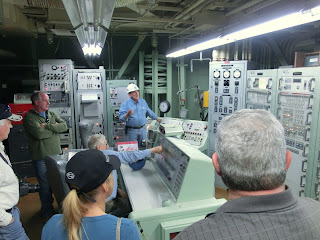In 1957, the Soviet Union launched Sputnick. To this
demonstration of rocket capacity, the United States responded with a vigorous
and focused effort to develop both space and ICBM programs. By 1963, after a 3 year development
program, the US began to deploy the first of its 54 Titan II Missiles as part
of the Mutual Assured Destruction strategy (MAD) and the world lived with a
balance of deterrence. This theory
postulated that the Soviet Union would not use a nuclear weapon since it
recognized that the United States would retaliate with its own nuclear arsenal that
would obliterate the Soviet Union itself.
The plan clearly depended
on the rationality of the two main adversaries.
From 1966 to about 1985, our 54 Titan missiles, each
with a single 9 megaton hydrogen warhead, guaranteed our security. Eighteen were located over an extensive
region in the desert area south of Tucson. It took only 58 seconds to launch the
missile after the command was given to the four man crew at each missile
silo. The missile would take about
30 minutes to travel its full 6,300 mile range to one of the three sites that
had been pre-targeted for each particular missile. The crew did not know the destination of the single missile
for which they were responsible, except by numbers 1, 2 or 3.
 |
| Control Room |
 |
| Shock Absorbers to insulate the entire missile silo from an enemy atomic blast |
 |
| OOPS! Bob turns key to fire the missile. |
 |
| Titan missile in its silo, ready to be launched |
In the mid-1980’s the liquid fueled Titan
II missile was replaced by the solid fueled Minuteman Missile then stationed in
the north central parts of the US. After it was decommissioned as a weapon, the Titan missile had many iterations that were used in space launches
for both military and non-military purposes. No launch ever failed. The Titan was retired after its last ignition in 2005 at Vandenberg Air Force Base in California. The Titan missile, originally developed as the
ultimate military deterrent, achieved its greatest successes as the launching
platform for at least 10 manned space flights of the Gemini program, multiple
interplanetary probes, many weather and communications satellites. In retrospect, with all its successes, it
may be best known as the great peace keeper during the Cold War era.
For more information about this particular missile site:
http://en.wikipedia.org/wiki/Titan_Missile_Museum
And for more information about the Titan missile in general:
http://en.wikipedia.org/wiki/Titan_%28rocket_family%29Photos courtesy of our friend, Kirk DeNee